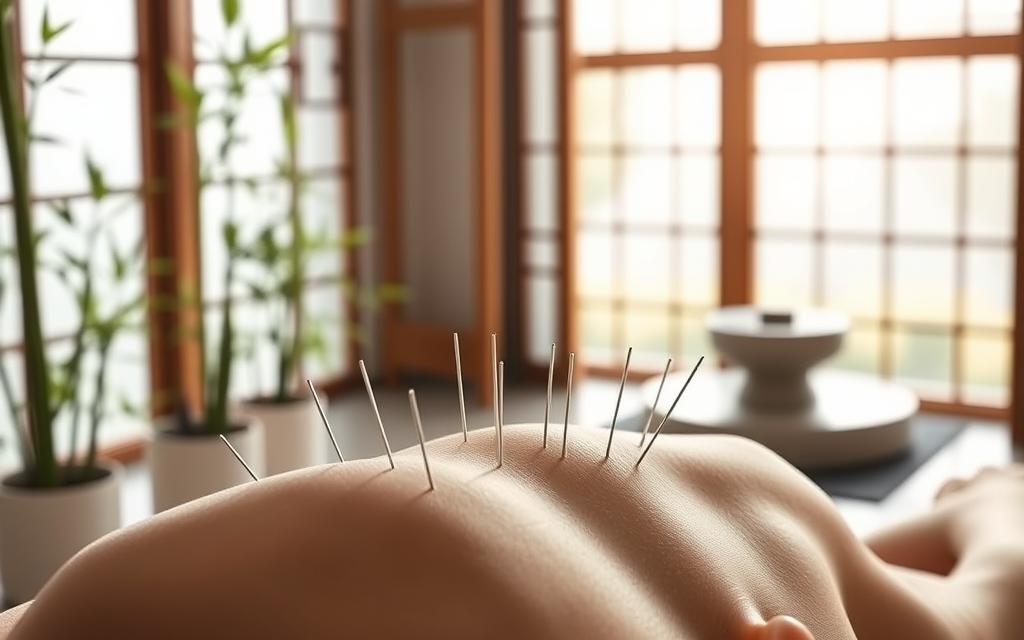Living with a chronic illness is tough. It tests our strength and will every day. Many of us look for new ways to feel better, beyond what doctors usually suggest.
That’s when we start thinking about alternative medicine. It might help us heal and find relief. Since many Americans deal with chronic health problems, it’s key to know how these treatments can help manage our conditions1.
We’ll look at different types of alternative medicine. We’ll see how they can make our lives better.
Key Takeaways
- Chronic illness affects millions of Americans, prompting interest in alternative medicine.
- Complementary treatments can enhance traditional chronic disease management strategies.
- Alternative medicine includes practices like acupuncture, chiropractic care, and naturopathy.
- Holistic approaches focus on the whole person, addressing root causes and symptoms.
- We can integrate alternative therapies with conventional methods for better health outcomes.
Introduction to Chronic Illness
Chronic illness is a long-term condition that needs ongoing medical care. It affects millions in the United States. Six out of ten Americans live with at least one chronic disease. Four out of ten have two or more, showing how common chronic conditions are2.
Examples include heart disease, cancer, diabetes, and chronic pain3. Living with a chronic condition affects more than just physical health. It also impacts emotional well-being, family life, and finances.
Managing chronic illnesses can disrupt daily activities like personal hygiene and dressing. This can lead to feeling bad about oneself and staying away from social events4. It can also strain family relationships, causing role changes in the home4.
Mood disorders like depression and anxiety are common in this group. But, they can be treated4.
Financial troubles often come when people with chronic illnesses can’t work. This affects their families too4. Managing chronic health means dealing with physical needs and emotional and financial challenges. Stress, anxiety, and uncertainty about the future are common, leading to more cognitive and physical symptoms4.
Support groups and counseling are key in coping with these challenges. They help us connect and stay strong.
Understanding the Scope of Chronic Illness in the U.S.
Chronic illnesses are a big problem for millions in the U.S. About half the population has at least one5. These diseases, like heart disease and diabetes, make up 86% of healthcare costs6. Sadly, they cause about 70% of deaths in the country5.
Managing these illnesses is key for both individuals and the healthcare system. It helps reduce the financial burden and improves health outcomes.
It’s estimated that 129 million Americans have at least one major chronic disease7. The cost to treat these diseases is around $4.1 trillion a year. This is nearly 90% of all healthcare spending7.
The number of people with these diseases has gone up by 40-150% since the 1980s6. This shows we need better ways to manage and prevent these diseases. Five of the top ten causes of death are linked to chronic diseases7.
Socioeconomic factors also play a big role, with health disparities in some areas7. Poor diet and lack of exercise make things worse5. Improving care for chronic diseases could save 30% of healthcare costs6.

Defining Alternative Medicine
Alternative medicine includes many alternative medicine practices not found in regular medical care. It includes things like acupuncture, yoga, and herbal remedies. These methods focus on treating the whole person, not just symptoms.
The term “alternative medicine” was used in the 19th century. It was to show it’s different from allopathic medicine, which uses drugs to treat symptoms8. There are five main types of complementary medicine. These are mind-body therapies, biologically based practices, manipulative and body-based practices, energy healing, and whole medical systems9.
At its heart, alternative medicine uses natural ways to heal and balance the body’s energy. It aims to treat the cause of illness, not just the symptoms8. Practices like yoga and acupuncture are safe and can help with stress and side effects of other treatments10.
It’s important to talk to healthcare providers before using these complementary medicine methods. This ensures they work well with regular treatments. About 38% of adults and 12% of children in the U.S. use alternative medicine9.

The Growing Popularity of Alternative Medicine
Alternative treatments have become more popular over the years. In 2022, about 36.7% of U.S. adults used them, up from 19.2% in 200211. People want care that fits them, not just standard treatments.
More folks are trying yoga, meditation, and massage. Yoga use jumped to 15.8% in 2022, from 5% in 2002. Meditation also rose to 17.3% from 7.5%11. These methods help with chronic pain and emotional health.
The COVID-19 pandemic boosted interest in alternative therapies. Demand for herbal supplements and mind-body practices grew. Social media helped spread the word about these treatments.
The U.S. market for alternative medicine is expected to grow a lot. It’s set to reach $229.12 billion by 2033, up from $28.65 billion in 202312. This shows more people are open to these treatments in healthcare.

Complementary and Alternative Medicine: An Overview
Complementary and alternative medicine (CAM) is key in managing chronic illnesses. Over 50% of US adults have at least one chronic condition, with 33.8% having two or more13. This shows we need good management strategies, like alternative therapies.
Many people use complementary medicine to improve their health. For example, 52.7% of adults take multivitamins, and 34.8% and 28.4% use vitamins and minerals, respectively13. Those with more chronic conditions are more likely to try CAM therapies.
Studies find that health literacy affects CAM use in the sick. People with higher education and insurance use CAM more14. This means access to info and resources can shape our choices in complementary options.

Dietary supplements are popular, with 54% of users15. Mind-body practices, used by 17%, are linked to higher absenteeism15. Our choices in alternative therapies can greatly affect our lives, mainly in managing chronic illnesses.
How Alternative Medicine Can Help Manage Chronic Illness
When dealing with chronic illnesses, we often look for new ways to treat them. Alternative medicine offers a holistic approach. It treats the whole person, not just the symptoms.
This method helps us tackle the illness from different angles. It looks at the physical, emotional, and spiritual sides of health.
Holistic Approaches to Treatment
Holistic care treats the mind, body, and spirit together. It aims to find the illness’s root cause. This way, it improves our overall quality of life16.
Practices like yoga and acupuncture can manage chronic pain well. Mindfulness techniques also boost our emotional health. They make us stronger against chronic conditions.
Studies show that making lifestyle changes can save up to 75% of U.S. healthcare costs. These changes include diet and lifestyle adjustments to prevent chronic diseases17.
Potential Benefits of Using Alternative Medicine
Looking into the benefits of alternative medicine shows great results. Nutrition counseling and herbal supplements can help with heart disease and diabetes16. Mindfulness-based therapies also improve physical function and reduce pain18.
By regularly practicing these methods, we gain control over our health. We move towards better health with more confidence.

Conventional vs. Alternative Treatment Methods
When it comes to managing chronic illnesses, we see big differences between traditional and alternative treatments. Traditional medicine often uses drugs and surgery to treat symptoms and diagnose diseases. On the other hand, about 20% of Americans choose alternative medicine instead, or use both together19.
This shift towards alternative options is driven by a desire for more personalized care. People want treatments that consider their whole health, not just symptoms.
Alternative medicine focuses on natural healing and finding the root cause of problems. It’s different from modern medicine, which might not explore these areas as much. Around 33% of those with chronic conditions use alternative treatments along with conventional ones19.
Many patients see the value in holistic medicine. They like how it aims to heal the whole body, using things like herbs and supplements20.
Combining traditional and alternative treatments is becoming more common. About 54.9% of users mix both methods21. This way, patients can create treatment plans that fit their unique needs, balancing symptom relief with overall health.
Looking at how treatments compare, we see the benefits of each. By understanding the strengths of traditional and alternative medicine, we can push for healthcare that meets patient needs. This way, we can ensure effective treatments that respect patient choices.

Exploring Various Alternative Medicine Therapies
We often look into different ways to manage chronic illness. Acupuncture and chiropractic care are two options worth checking out. They offer benefits that can improve our health and life quality.
Acupuncture and Its Benefits
Acupuncture is known for helping with chronic pain, nausea from chemotherapy, and fatigue. It works by releasing endorphins, which block pain signals to the brain. This makes it a good choice for those with ongoing pain2223.
The World Health Organization says acupuncture helps over 30 health issues. Many people see their symptoms improve after regular treatments23.
Chiropractic Care for Pain Management
Chiropractic treatments aim to relieve musculoskeletal pain and improve body function. It can help with back pain, headaches, and neck pain23. Studies show it can manage some conditions, though evidence for chronic pain relief varies.
Regular chiropractic care can reduce discomfort and boost overall health. This leads to a better quality of life24.

Integrating Alternative Medicine into Chronic Disease Management
Managing chronic illness requires teamwork among healthcare providers, patients, and alternative practitioners. This teamwork is key to avoiding harmful interactions between treatments. By being involved in our health care, we can see big improvements in our well-being.
Studies show that Ayurveda’s herbal remedies and lifestyle changes help with chronic diseases like arthritis and diabetes25. Acupuncture also helps by reducing chronic pain and lowering blood pressure25. Yoga adds to these benefits, improving blood sugar control and reducing stress, making it a great addition to our care plans25.
By taking a holistic view, we focus on all aspects of life and health, leading to better lives and health outcomes26. Using integrative methods can reduce our need for drugs by using acupuncture and physical therapy for pain26. Mindfulness practices also help manage chronic pain, fatigue, and anxiety, showing the importance of mental health in our care26.

Strategies for Managing Chronic Illness Effectively
Managing chronic illness needs a full plan. We can use many effective ways to manage it. Simple changes in our lifestyle are key to a healthier life. For example, keeping blood pressure in check helps avoid heart attacks and strokes27.
Knowing about high cholesterol and making diet changes can also improve health27. Lowering blood sugar is possible by avoiding foods that raise glucose levels27.
Being active is crucial. We should aim for 150 minutes of moderate exercise each week. Sadly, many Americans don’t get enough27. Using support groups, like the Arthritis Self-Management Program, can lead to less pain and fewer hospital visits28.
Programs tailored for specific groups, like the Latino community, have shown great success in health management28. Using treatments like TEENCOPE helps young people manage their health better28.
Weight loss of 5–10% can greatly improve health and manage chronic conditions27. Cutting down on sodium by eating less processed food can also help control blood pressure27. Quitting smoking is another step towards lowering heart disease risk27.
These steps help us on our path to better health. They show the power of a multi-faceted approach to managing chronic illnesses.

Self-Care for Chronic Conditions: Tips for Success
Living with chronic conditions means we need good self-care. Regular exercise like stretching, walking, or yoga helps a lot29. Eating a variety of fruits and veggies boosts our immune system29. Drinking water or fruit-infused water keeps us hydrated29.
Good sleep is key. Stick to a regular sleep schedule and have a relaxing bedtime routine29. Mindfulness, like deep breathing or meditation, reduces stress and improves mood29. Journaling and practicing gratitude can also boost our mental health29.
Being in nature is good for our mind and spirit. Whether it’s a walk or gardening, it helps us relax29. Joining groups or classes helps us feel connected and less lonely29. Managing our energy helps us do our daily tasks without getting too tired30.
Cognitive-behavioral therapy (CBT) is great for our emotional health30. Doing things we enjoy can lower stress and make life better30. The spoon theory helps us plan our day without feeling overwhelmed30.
Having family and friends support us is very important30. Their help improves our communication with doctors and helps us stick to our treatment plans30. Setting small goals and tracking our progress keeps us motivated30.
Support for Managing Chronic Illness
Many people in our community live with chronic illnesses. About 6 in 10 adults in the United States have one. And, 4 in 10 adults deal with two or more, making life harder31. It’s important to have a strong support system to face these challenges.
Friends and family are key. They offer strength and understanding. They help us feel less alone.
Being part of the local chronic illness community helps a lot. Support groups let us connect with others who get it. They offer comfort and motivation when we need it most32.
They also teach us how to manage stress and stay positive. This helps us find ways to deal with our illnesses better.
Also, getting psychological counseling can help us stick to our treatment plans. This leads to better health outcomes. Learning to communicate our needs clearly helps us build stronger support networks32.
Having both emotional and practical support is crucial. It helps us stay strong and manage the ups and downs of chronic illnesses.
Research and Evidence of Alternative Medicine Efficacy
Research shows that more people are turning to alternative medicine for chronic diseases. A study found that 32.8% of those with non-communicable diseases use alternative medicine for better health33. This medicine is used for many conditions, like chronic pain, mental health issues, and heart problems34.
A survey in the U.S. saw a big jump in the use of alternative health methods. From 19.2% in 2002 to 36.7% in 2022, showing a clear trend towards these methods, mainly for pain35.
Studies support using alternative medicine in regular healthcare to improve patient care34. In Saudi Arabia, a CAM center was set up to support these practices, showing a global trend34. Around 15.3% of patients use alternative medicine alone, while 17.5% use it with traditional medicine33.
People choose alternative medicine because of side effects and costs of traditional drugs34. In India, about 13% of middle-aged and older adults use alternative treatments with regular care for chronic diseases35. Higher education might make people less likely to use alternative medicine alone but more likely to use it with traditional medicine, mainly among the young33.
There’s a strong need for more clinical trials to prove the effectiveness of alternative medicine for chronic conditions35.
Conclusion
Alternative medicine is key in managing chronic illness. It shows us the need to look beyond traditional health care. This is true for conditions like asthma36.
Using evidence-based methods can improve how we talk about health. This leads to better health results.
Making lifestyle changes and managing stress helps us deal with chronic conditions37. Getting enough sleep and having a supportive network are also crucial. Working with healthcare professionals helps us manage our illnesses better.
This approach not only helps with chronic illness but also improves our quality of life. By working together, we can make our health journeys better. This way, we can achieve the best wellness possible.
FAQ
What is alternative medicine?
Alternative medicine includes practices not in standard care, like herbal remedies and acupuncture. It aims to treat the whole person, not just symptoms.
How can alternative medicine complement conventional treatments for chronic illness?
Alternative medicine can boost health when used with standard treatments. It focuses on natural healing and the person’s overall well-being.
What are some common alternative therapies used for chronic disease management?
Common therapies include acupuncture and herbal medicine. They help manage symptoms and improve life quality for those with chronic conditions.
Is there scientific evidence supporting the use of alternative medicine for chronic illness?
Yes, many studies prove alternative therapies’ effectiveness. They are key in integrative healthcare.
What role does self-care play in managing chronic health issues?
Self-care is vital for managing chronic health. Activities like exercise and mindfulness help us take control of our health.
How can we build a support system while managing chronic illness?
Building a support system means connecting with friends and family who get it. Support groups offer emotional and practical help, boosting resilience and health.
Source Links
- 5 Ways to Treat Chronic Illness with Alternative Medicine – National University Of Health Sciences – https://www.nuhs.edu/5-ways-to-treat-chronic-illness-with-alternative-medicine/
- About Chronic Diseases – https://www.cdc.gov/chronic-disease/about/index.html
- Chronic Disease Management Guide for Patients and Families – https://online.utulsa.edu/blog/chronic-disease-management-guide/
- Chronic Illness: Sources of Stress, How to Cope – https://my.clevelandclinic.org/health/articles/4062-chronic-illness
- Chronic condition | EBSCO – https://www.ebsco.com/research-starters/consumer-health/chronic-condition
- The Relation of the Chronic Disease Epidemic to the Health Care Crisis – https://pmc.ncbi.nlm.nih.gov/articles/PMC7077778/
- Sociodemographic and Geographic Variations by Zip Code Tabulation Area – https://www.cdc.gov/pcd/issues/2024/23_0267.htm
- Alternative Medicine – StatPearls – NCBI Bookshelf – https://www.ncbi.nlm.nih.gov/books/NBK538520/
- Types of Complementary and Alternative Medicine – https://www.hopkinsmedicine.org/health/wellness-and-prevention/types-of-complementary-and-alternative-medicine
- Complementary and Alternative Medicine (CAM) – https://www.cancer.gov/about-cancer/treatment/cam
- NIH analysis reveals a significant rise in use of complementary health approaches, especially for pain management – https://www.nih.gov/news-events/news-releases/nih-analysis-reveals-significant-rise-use-complementary-health-approaches-especially-pain-management
- U.S. Complementary And Alternative Medicine Market Size to Hit USD 229.12 Bn by 2033 – https://www.biospace.com/u-s-complementary-and-alternative-medicine-market-size-to-hit-usd-229-12-bn-by-2033
- Results From the 2012 National Health Interview Survey – https://www.cdc.gov/pcd/issues/2016/15_0501.htm
- Frontiers | The relationship between use of complementary and alternative medicine and health literacy in chronically ill outpatient cases: a cross-sectional study in southeastern Iran – https://www.frontiersin.org/journals/public-health/articles/10.3389/fpubh.2023.988388/full
- Complementary and alternative medicine use and absenteeism among individuals with chronic disease – BMC Complementary Medicine and Therapies – https://bmccomplementmedtherapies.biomedcentral.com/articles/10.1186/s12906-016-1195-9
- How Holistic Care Helps with Chronic Disease Management – https://www.floridamedicalclinic.com/blog/chronic-disease-management/
- Integrative medicine to tackle the problem of chronic diseases – https://pmc.ncbi.nlm.nih.gov/articles/PMC3149386/
- 5 alternative treatments for chronic pain – https://www.uclahealth.org/news/article/5-alternative-treatments-chronic-pain
- 2. Americans’ health care behaviors and use of conventional and alternative medicine – https://www.pewresearch.org/science/2017/02/02/americans-health-care-behaviors-and-use-of-conventional-and-alternative-medicine/
- Explained: Holistic vs Modern Western Medicine » Global Autoimmune Institute – https://www.autoimmuneinstitute.org/articles/explained-holistic-vs-modern-western-medicine
- Complementary and Alternative Healthcare: Is it Evidence-based? – https://pmc.ncbi.nlm.nih.gov/articles/PMC3068720/
- Integrative Medicine and Health – Overview – https://www.mayoclinic.org/departments-centers/integrative-medicine-health/sections/overview/ovc-20464567
- Alternative Therapies and Pain Management – https://www.webmd.com/pain-management/pain-management-alternative-therapy
- Complementary and alternative medicine – https://www.nhs.uk/conditions/complementary-and-alternative-medicine/
- Integration of Alternative and Complementary Medicine with Modern Western Medicine for Enhanced Patient Care | Auctores – https://www.auctoresonline.org/article/integration-of-alternative-and-complementary-medicine-with-modern-western-medicine-for-enhanced-patient-care
- How Integrative Medicine is Changing the Approach to Chronic Disease Management – Authentidate – https://authentidate.com/how-medicine-is-changing-the-approach-to-chronic-disease/
- 7 steps patients should follow to reduce, manage chronic disease – https://www.ama-assn.org/delivering-care/public-health/7-steps-patients-should-follow-reduce-manage-chronic-disease
- Self-Management: A Comprehensive Approach to Management of Chronic Conditions – https://pmc.ncbi.nlm.nih.gov/articles/PMC4103232/
- Self-care tools for chronic health conditions – https://www.canr.msu.edu/news/self-care-tools-for-chronic-health-conditions
- How to manage chronic conditions effectively – https://www.willowshealthcare.com/blog/how-to-manage-chronic-conditions-effectively
- Living Well with Chronic Illness: Strategies for Managing Your Health – https://www.avmc.org/blog/2023/april/managing-chronic-conditions-strategies-for-livin/
- Mental Health and Chronic Disease, Summit Healthcare, Show Low, AZ – https://summithealthcare.net/blog/chronic-care-management/the-importance-of-mental-health-support-in-chronic-disease-management/
- Prevalence and determinants of using complementary and alternative medicine for the treatment of chronic illnesses: A multicenter study in Bangladesh – https://journals.plos.org/plosone/article?id=10.1371/journal.pone.0262221
- Evidence-Based Complementary and Alternative Medicine in Current Medical Practice – https://pmc.ncbi.nlm.nih.gov/articles/PMC10857488/
- Exploring the efficacy of integrative medicine for chronic conditions: The role of combining allopathy, ayurveda, homeopathy, naturopathy, diet and lifestyle – https://www.jpmhh.org/html-article/23448
- Management of chronic disease by practitioners and patients: are we teaching the wrong things? – https://pmc.ncbi.nlm.nih.gov/articles/PMC1117606/
- How to Manage Chronic Diseases Effectively – https://infinitycarehospital.com/how-to-manage-chronic-diseases-effectively/
